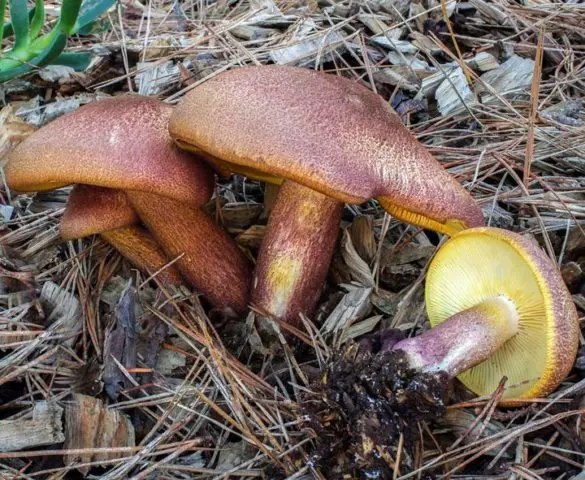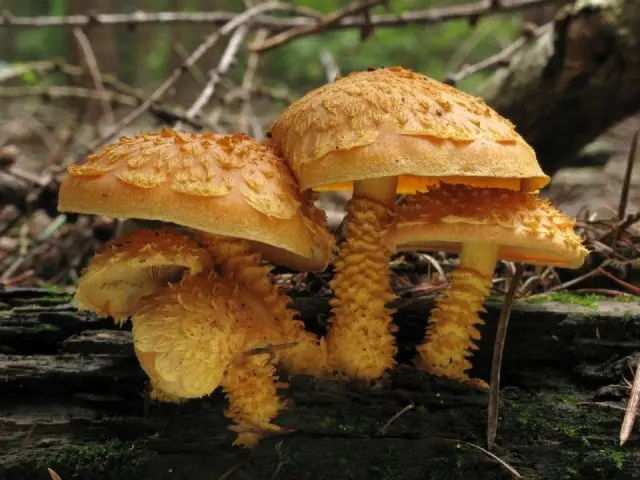Contents
Yellow-red rowing is a representative of agaric mushrooms that grow in Our Country. It is distinguished by the bright color of the hat. Eat with caution, only after heat treatment.
Where does the yellow-red row mushroom grow?
The yellow-red variety of rowing comes across mushroom pickers quite rarely. These mushrooms prefer damp areas in coniferous forests. Their fruiting bodies grow on stumps, deadwood, in windbreaks. More often, the mycelium develops on dead wood of larch, pine and other conifers.
The yellow-red row, or tricholomopsis rutilans, appears from July to early October. In central Our Country, the peak of fruiting occurs at the end of July and lasts until September. Fruiting bodies appear in small groups of 3-4 pieces.
Description of the yellow-red row
According to the photo and description, yellow-red rowing is a representative of agaric mushrooms of the Ryadkovye family. In young specimens, the hat is convex. Gradually, it grows and becomes flatter. Its fleshy, matte surface resembles velvet to the touch. The size of the cap is from 7 to 15 cm. Its color is yellow, with an orange or red undertone.
Small scales are located on the surface, they are usually brown-red or purple. Notched, with spikes along the edges, the plates are firmly attached to the hat. Their main color is yellow. Spores are white.
The leg, solid inside, and in old specimens – hollow, grows up to 10 cm, in girth – from 1 to 3 cm. Its shape is cylindrical, often curved, the color is the same tone with the cap. The scales are purple or lighter in color.
Saturated yellow flesh in the cap is more dense, in the region of the leg – fibrous. It smells sour, reminiscent of rotting wood.

Is it possible to eat a reddening row
The yellow-red row is an edible variety, but its nutritional value is low. Both young mushrooms and adult specimens are suitable for consumption. In young rows of yellow-red, the flesh is bitter.
The taste of the mushroom
Because of the mediocre, without striking differences, taste, this variety belongs to the 4th category. This includes mushrooms that are allowed to be eaten. However, they are inferior to other types in taste and composition.
Benefits and harm to the body
The composition of the row includes minerals, vitamins of groups B, C, A, K, amino acids, natural antibiotics. The product is recommended for dietary nutrition and people who are actively involved in sports.
Eating mushrooms benefits the body:
- the level of sugar and pressure is normalized;
- the heart rhythm is restored;
- signs of overwork and fatigue are removed;
- increases the body’s resistance to viruses;
- slows down the growth of cancer cells.
Mushrooms are taken with caution in diseases of the kidneys and gastrointestinal tract, after consulting with a doctor. The product is not recommended for children, women during pregnancy and during breastfeeding.
Yellow-red rowing harms the body when overeating. The daily norm of the product is no more than 150 g. If it is violated, there are pains in the stomach, nausea, diarrhea, and weakness. In such cases, you need to wash the stomach: drink warm water and induce vomiting. The patient should be given bed rest and activated charcoal.

False doubles
The yellow-red row has twins. These are mushrooms that are similar in shape and color. Not all of them are edible, which is why it is so important to distinguish them from rows.
False doubles of the yellow-red row:
- Tricholomopsis beautiful. An inedible variety that has a bright yellow color. A convex or flat cap has a diameter of 4-6 cm. A cylinder-shaped leg reaches 8 cm. The nutritional qualities of this species have not been studied. It is known that the pulp of its representatives contains toxins.

- false honey agaric. Grows in large groups next to fallen trees and stumps. Its leg is elongated, reaches 12 cm, in diameter – 2,5 cm. The hat is convex, in the central part it is darker in color. Most of all, the brick-red variety of false foam is similar to rowing. Its color is reddish-brown, sometimes with a yellow tinge. When eaten, this fungus causes poisoning.

- Flake fiery. This double parasitizes on dead wood. Its hat is 3-7 cm in size, spherical or flat, with bright yellow scales on the surface. The flake is not a poisonous mushroom, but it is not eaten because of its bitter taste.

Collection rules
Yellow-red rowing is harvested from mid-summer to late autumn. It is best to choose young specimens whose hat has not yet become flat. The fruit body is carefully cut at the root so as not to damage the mycelium. If the pulp is wormy, then it is not taken into the basket.
Preparation of a row of yellow-red
Row is subjected to various types of processing. First, the collected mass is placed for 3-4 hours in cold water. Then it is drained, the mushrooms are cut into pieces and poured into a saucepan. Fruit bodies are poured with cold water, put on the stove and boiled for 40 minutes. Then the broth is drained, and the mushroom mass is cooled.
The resulting product is stored in the freezer or used for further cooking. It is added to soups, salads, side dishes, combined with vegetables and meat dishes. The pulp is crushed to prepare caviar, where onions and carrots are also added.
Conclusion
Yellow-red rowing prefers damp places next to coniferous trees. It is harvested from the second half of summer. The mushroom is used as food only after heat treatment. It is important to distinguish a variety from twins, among which there are inedible specimens.












